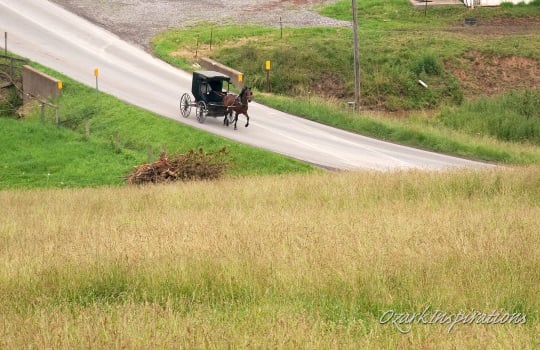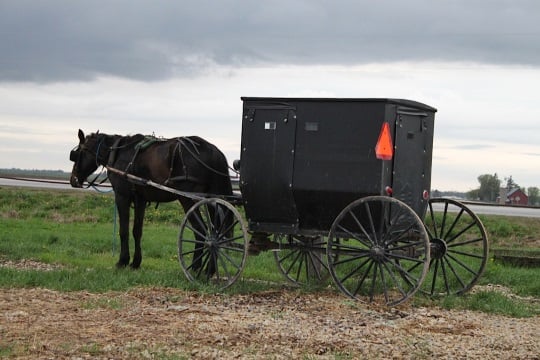One Million Amish By 2050?
The Amish population is growing fast. It’s been growing fast for decades. And that doesn’t seem to be changing. How large will the Amish population get in our lifetimes?
On the recent 1950s Amish film post, Lance left a comment that brought this back to mind:
In 1900 there were just 5000 total Amish world wide. By this video’s filming, there were 8000 in just Lancaster Co, PA. Now there are hundreds of thousands and still growing fast. A million Amish by 2050?
Could there be a million Amish by 2050? Or thereabouts?

A million Amish? Doing the (rough) math
Since math is not my strong suit, let’s just do a very basic calculation. The most recent Amish population figures (2022) via the Young Center at Elizabethtown College put the total number of Amish people at 373,620.
The doubling time for the Amish population has been calculated to be anywhere from about 20.5 to 23.5 years, representing an annual growth rate of about 3 to 3.5 percent (though as Joe Donnermeyer noted in 2015, a small difference in the rate can make a significant difference when compounded over time).
But again this is a ballpark calculation. So if we choose a number right in the middle – 22 years, and use that figure, then by 2044 the Amish population can be expected to reach 747,240 people.
Do that again and you have almost 1.5 million Amish by 2066. So it’s fair to say that the Amish population will likely cross the 1 million-person threshold sometime in the 2050s. Assuming nothing big changes…
Assumptions on Amish growth
There are some assumptions you’d have to make for the rate of growth to continue as it has up til now, however.
1.No major external disruptions
You’d have to assume there wouldn’t be any major disruptions that caused a significant part of the current Amish population to cease being Amish (in other words, leave the Amish way behind for a more modern, non-Old Order religious identity). This has happened on more than one occasion in Amish history.
Those could be things like the progressive influence of other churches, technology, or economic pressures leading a significant number of people to leave the Amish church.
2.Amish birth rate stays the same
This would also assume that Amish birth rate doesn’t drop. Evidence from certain communities suggests this might be happening, but in other communities, not really at all.

3.Amish youth continue joining at same rate
It would also assume the numbers of Amish young people who choose to join the church doesn’t drop significantly, either. That number ranges from about 60-95%, depending on the specific Amish group.
So there are some assumptions baked into the cake there. There might be others I’m leaving out as well.
However, Amish have shown themselves to be adaptable when it comes to accepting some technological change (agricultural tech for instance) if it allows them to keep providing for themselves in traditional occupations like dairying. They’ve also shown adaptability in the array of businesses they have taken on, and thrived in.
Looking even further ahead
A dozen years ago I did a post looking even a bit further into the future. In “Seven Million Amish by 2100?” I related an account of an Amishman, interested in the demographics topic, who once shared with me some back-of-the-envelope figures. Here are the interesting bits:
He had worked out the theoretical Amish population far into the future, using the assumption that it doubles every 20 years.
The numbers get big quickly. Total Amish population (currently 250,000) hits a million sometime in the 2050s, and rockets from there.
A recent academic study (on the spread of a “religion gene“) touches on the same topic. The study’s author uses a similar calculation to predict 7 million Amish by 2100.
If you use my rough math from above, you get about six million Amish by about 2110. Again the rate you use makes a significant difference over time, and the rate can (even would be expected to) change.

Finally, for perspective, I also added this on that 2011 post. At the time the Amish population was about 250,000:
To put this in perspective, 7 million Amish would be:
-
- nearly 30 times today’s Amish population
- about equal to the current population of Washington state
- larger than the present population of Denmark, Paraguay, and about 100 other countries
And to put it another way, a population of seven million would be larger than the current populations of 35 states.
These numbers are all fun to play with, and to imagine what an America with millions of Amish people might look like (come to think of it, that might need its own post). But as someone once said, “It’s tough to make predictions, especially about the future.” 😉








I hope so!
Between the Amish, Old Order Mennonites in the US and Canada, and the Russian Mennonites(actually Germans) in Bolivia, who have roughly tripled their population in 16 years…a growth rate of nearly 8%, it’s safe to say the American continent will have an Anabaptist future!
The one million or so Haredi Jews in the US, with their growth rate of 4.5%, will also be contenders for that prize, possibly 30 million by 2100. They all just need growth rates in 100 years to be the same as they are now for that to happen!
One can hope...
My crystal ball is as cloudy as everyone else’s, but I would stir in some anecdotal thoughts and concepts. While I don’t have staggering amounts of evidence, most of the Amish I an acquainted with have a good understanding of the value of their belief system and lifestyle. The same cannot be said of the Englisch. I wonder if the retention rate among the Amish will increase as the differences become more extreme and obvious. I’ve become acquainted with a young Amish girl who made a very deliberate and thoughtful decision to become baptized and stay Amish. Since she has had some freedom, I asked her what she will miss the most. She immediately responded that becoming Amish is not about giving things up; it is about gaining things, and she was quite capable of listing the gains. I just talked to her again recently (a year later), and she is even more committed, continues to work in the family business, has started her own business, and is “in a relationship.” If she is representative of the next generation of Amish, there is hope. It would be interesting to envision a society where the Amish are the majority. It gives a new meaning to “back to the future.”
Nice anecdote Walter. I think just as in other faith backgrounds, some are more thoughtful about it and some are more just “go with the flow”. Though being such a distinct sub-culture seems like it would encourage thoughtfulness about one’s lifestyle and faith, especially since it is constantly in contrast with the dominant culture.
Interesting. But an increase in numbers is not the same as an increase in those maintaining the Amish culture, attitudes, and behavior that many of us associate with Amish.
The Ordung is always changing. So how will the Ordung change by 2050 or 2100 for the various Amish communities and what affect will these changes have on them?
We see many are allowed to use cell phones and how that has changed some of their attitudes and behaviors.
Many want to drive(the baptized adults and not just for work) And will these changes assist the Amish in their assimilation to the English? If so, how much?
Technology use can be seen as a symbol of change. Something tangible. But what is going on inside a person’s heart and mind can be more difficult to measure. And I think that is a statistic, if measurable, would carry more weight than population numbers.
Will another 50 -100 years living more closely to the ‘Englisch’ continue to slowly assimilate them to become more ‘of this world’ and not just ‘in this world?’ Time will tell.
Good points that you raise, and the way that some Amish live today, while keeping an Old Order identity (buggy/plain clothing/PA Dutch language) etc. would seem very progressive to their predecessors of half a century ago.
I wonder if there will come a point when say Swartzentruber Amish and the mainstream Old Order will really be seen as having distinct identities. Both still called Amish but the gap in lifetsyle, tech might become so great that it’s more helpful to think of them in different terms. Though some might say we are already there.
Are we underestimating the future of Amish population growth?
Let me add a few reasons why I’m bullish on Amish population growth. First, culture seems more influential on tfrs than occupation. The exodus from farming has lowered fertility decline for some groups from 8-9 cpw to 5-7 cpw, but others have transition w/ no decline at all. No wonder, Haredim / Hasidic Jews live in the city but reject technology and are very natalistic and religious which allows them to have an Amish / Mennonite level birthrate while living in the heart of modernity!!
The Swiss Amish of Adams Co have a tfr of 8-9. And the Andy Weavers are at 8 despite having left farming almost entirely. Both groups are highly conservative. Studies in some progressive settlements have also shown farmers there don’t have larger families than non-farmers.
Further, while most Amish no longer farm, there’s a constant stream of reactionary settlements founded in part for the purpose of farming. Hence their population boom in WI where they are taking over the dairy business. (Tfr across all WI settlements is a whopping 9.4.) (That said, except among the Swartzentrubers, farmers in these new settlements are often still a minority-albeit a much larger one than in their parent settlements. E.g. only 7% of Geauga County OH Amish farm, but in their 2 NY daughter settlements, 20 and 25% do.)
But more important to the future of Amish growth is the fact that unlike with us, conservative movements among them succeed. They do this not by winning hearts and minds but by simply separating from their liberal cousins and cutting the ties of fellowship. Progressive Amish use the same tactic when frustrated by conservative majorities in their church. However, tfrs among Amish affiliations fall on a range of 5-11 with a strong correlation between conservativism and fertility. Retention rates (50-97%) show the same correlation.
In short, the decentralized nature of the Amish faith has a built-in mechanism to preserve and expand its pro-natalist component which, so far, has proved fairly effective in countering individualistic influences from both more liberal affiliations and the world at large.
One could almost say that there is a continuous selective pressure to favor the groups/families that manage to maintain the highest birth rate because they produce more children & have a higher retention rate. According to studies of The Journal of Plain Anabaptist Studies, the more ”anti-tech” Amish have a much shorter time between births, which means that the 8th child of a conservative Amish arrives much earlier in life than the average 8th child of an Old Order Amish. The “conservative” Amish will therefore have grandchildren sooner, another advantage in group selection).